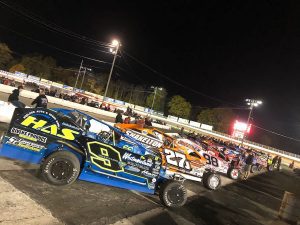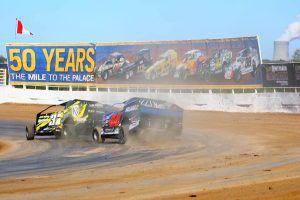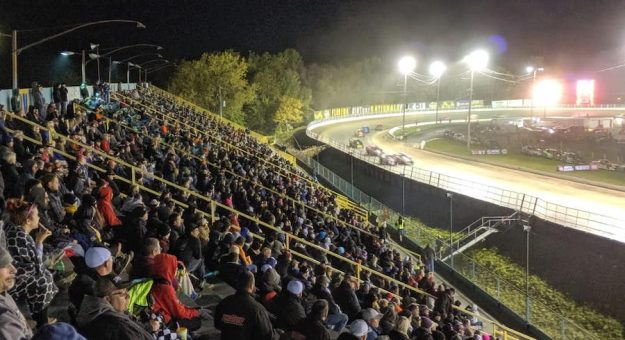With the 51st Super DIRT Week on tap Oct. 2-8, World Racing Group officials announced the latest in a string of seemingly yearly format changes for the headline event, the Billy Whittaker Cars 200 for big-block modifieds.
Coupled with past adjustments, Super DIRT Week may still be racing’s biggest party but the program itself is now vastly different than what old-timers remember.
Whether the changes to the race – a longtime fixture on the venerable Syracuse Mile before shifting to a dirt-covered five-eighths-mile oval at Oswego (N.Y.) Speedway in 2016 – are an improvement remains an open question.
Detractors see the move to scheduled pit stops on or around laps 75 and 125, with the lap counter frozen and teams given four laps to add gas and work on their cars, as an effort to distract fans and competitors from the seemingly yearly conversation regarding a rutted, peeling racing surface.

Proponents see a strategy-heavy race with safer pit stops for teams not used to NASCAR-style stops. Teams will still be able to pit at will under other yellow flags, though fuel can only be added on the controlled stops.
A somewhat similar format in 2022 only allowed gas to be added during a lap-100, full-field stop.
With the use of radios also eliminated, the format will allow for a variety of strategies, with many teams expected to add fuel on the first controlled stop and then stay out during round two to gain or maintain track position as cars that stop rejoin the field in the order in which they entered the pits.
“We have to stop for gas at least once, so we’ll have to hit one of them,” offered Mike Mahaney, who won the Super DIRT Week qualifier at Quebec’s Autodrome Drummond. “You can work on the car too, so we can adjust and try to make it better. You’ll go to the tail in the order you pitted, so track position before the controlled stops will be important, too.
“Without the radios, teams with really good spotters will lose that advantage. And you won’t be able to tell your crew to be ready to change a shock or make a particular change you want. It will be a different race, for sure. But I think DIRT is trying to save us money with no radios and fewer pit guys needed. It will also help with a quicker turn-around after the Outlaw 200 at Fulton the weekend before. We might not even go home, just stay in the area and run the same big block at both races.”
“I agree that they are trying to make it easier for average guys,” added series regular Peter Britten. “I don’t think it will take much away from the event and it might even improve it by getting rid of the ‘radio racing,’ which is a polite term for blocking.
“Now, it will be just like any other race. When I come in for fuel and tires, they’ll find out what else I need and then do it. Unless I have to, I won’t come in for the second controlled stop. But you can try a lot of different strategies. You could come in for tires at 150 laps if you think you’ll be good enough to come back through the field.”
Mahaney feels the Oswego pits are much safer than the cinder track used at Syracuse, where the field would not physically fit in the tiny stalls if lined up bumper to bumper. By contrast, Oswego’s asphalt pit area is wide with stalls spread out along both sides of the pit lane.
“I also like that you can stop better on the asphalt instead of sliding in,” added Mahaney. “All in all, the facility and the format are much safer for the crew guys. It makes it more like a regular race, only longer. If the track is good, we’ll have a good race. But they need dry weather when the clay goes down and then have to work it properly. In the past, we’ve had some good surfaces, but when we had a wet fall or the guys doing it disagreed on how to lay the clay down, we raced on some horrible ones.”
“I think they’re still looking for a way to make the event unique,” offered NASCAR Craftsman Truck series driver Stewart Friesen, who has four Syracuse victories and an Oswego 200 score on his résumé. “On the one hand they want to attract a bunch of Saturday night racers, on the other hand they want something unique, not just another race.
“The changes might even hurt the Saturday night racers depending on how the race plays out, we might stay out during the second break. But if we stop for both breaks, we’ll do tires at the same time and might even do a third set late in the race if it’s slick. That gets expensive. Everything depends on track conditions. It’s a crazy place. We’ve seen everything in the past and it’s all dictated by the weather.”
As for no longer using radios, Friesen said, “It is what is it.” But after more thought, he elaborated.
“Nobody else will have one either, but we’ll miss it because we used it to change plans and make our car better on stops,” Friesen noted. “Another place it would hurt is if a fast lane develops and a guy running fifth or sixth figures it out first. It’s nice to have the spotter tell you that before he passes you.”
Marc Johnson, a former Saturday night racer who has advanced to the Super DIRTcar Series and is always competitive during Super DIRT Week, is more vocal.
“I hate it all,” he said. “DIRT Week was one of those things where you got the crew involved more and they really enjoyed it. Now we’ve got all the radios and other stuff and don’t get to use it.

“We always spent all week and especially the night before the 200 planning our pit stops, and now we’re on their program. It takes most of the strategy out of it and narrows your options way down.
“With 200 laps and a spotter and my crew on the radio, you had an opportunity to fix issues that developed. Without the radios, fewer cars may finish. Things like that made it different from a regular race. When I first went to Syracuse, it was a really big deal. Now it’s just a regular race night. They might as well make it a two-day event.”
As always, racers are trying to second guess the motives of the sanctioning body. Johnson’s take is “they’re trying to get more cars, but there’s no place to put what they’ve got now. If they get a bunch of newcomers because of no radios and controlled gas stops, guys will be pitting in the campground.”
Friesen, for one, is a bit less emotional.
“No matter what, you can’t discount a $51,000-to-win race,” he said. “And the track and the format are independent of each other. Oswego is an historical venue and it’s cool to race there. It’s just as big a deal for me as going to Daytona with the Trucks except that there you don’t have to worry about dust or the surface breaking up.
“DIRT is doing the best that they can. As times change and social media and live streaming becomes more and more important, everybody is facing change and adapting to it. We have more eyeballs on us than ever and have to put on the best show possible.
“And I always tell myself, if we were still racing at Syracuse, it would have been paved by now and we’d all be out in the cold.”
This story appeared in the Sept 27, 2023 edition of the SPEED SPORT Insider.

